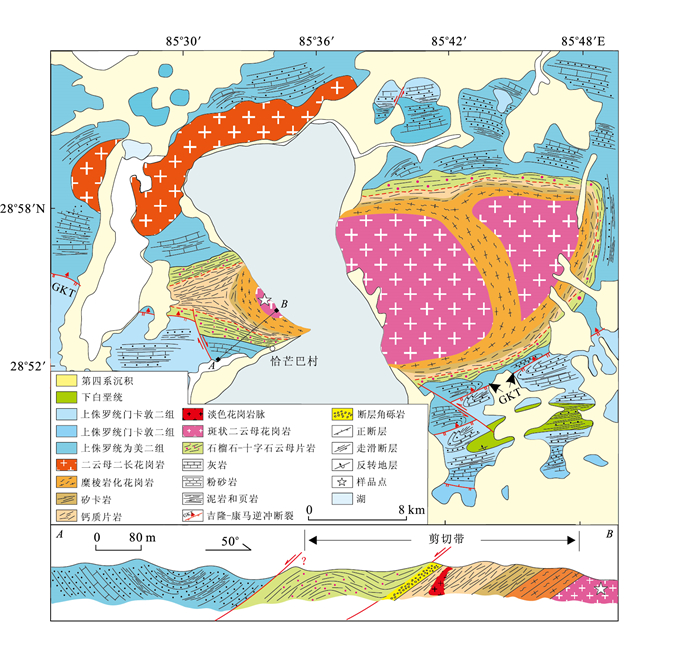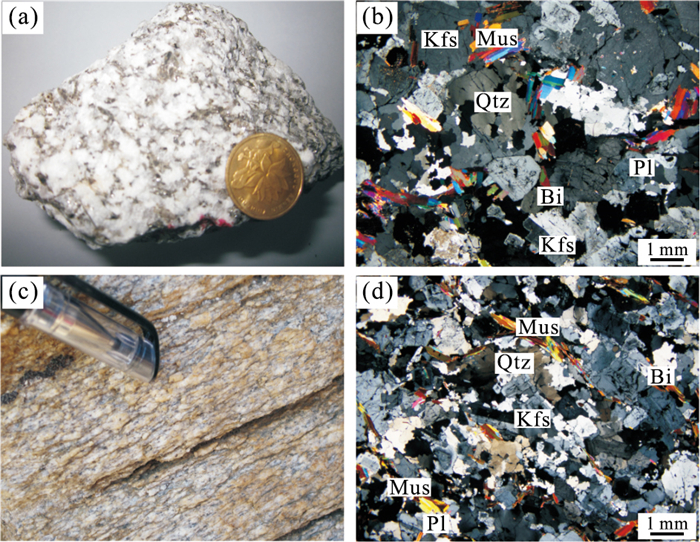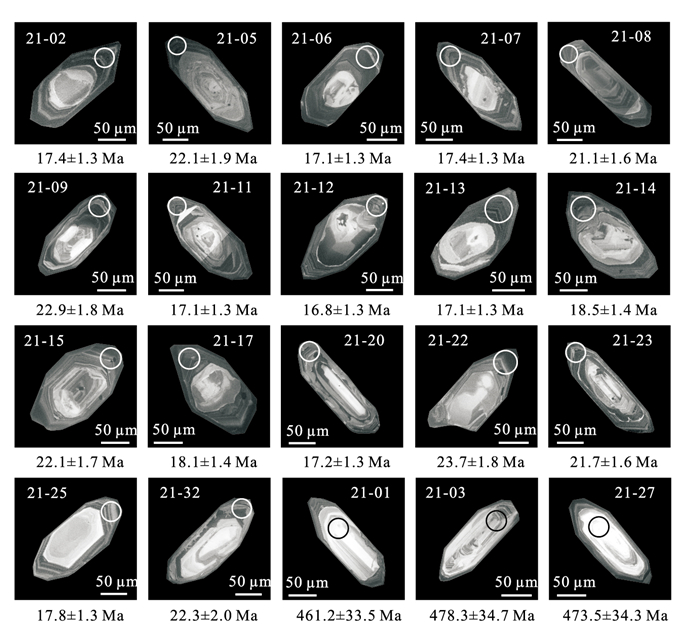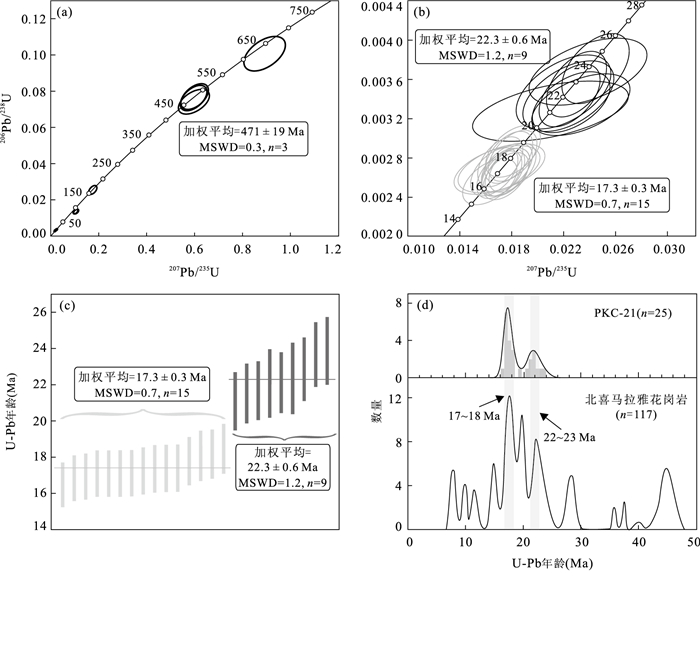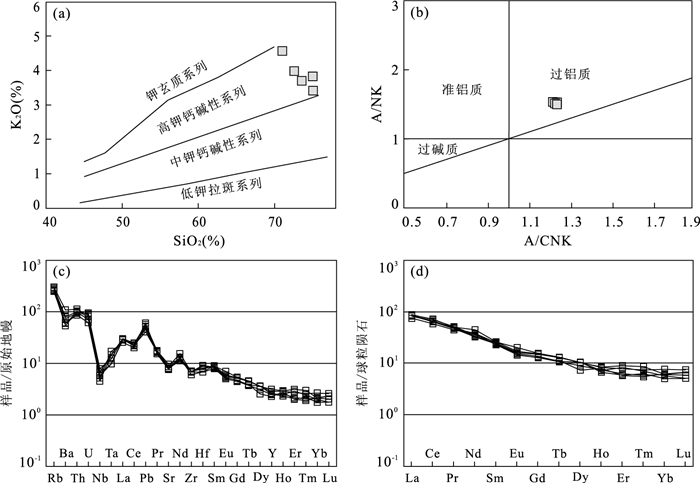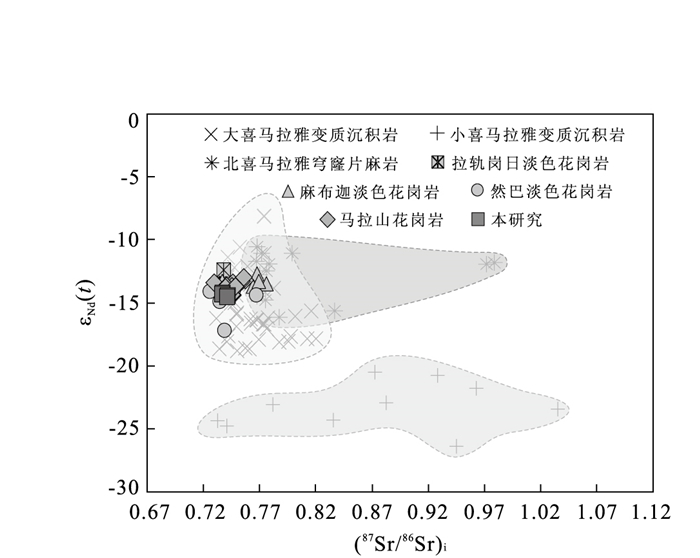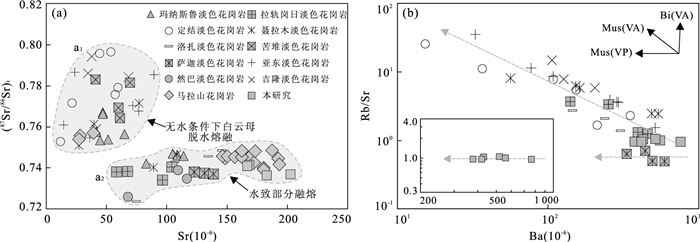Geochronology and Formation Mechanism of the Paiku Granite in the Northern Himalaya, and Its Tectonic Implications
-
摘要: 北喜马拉雅花岗岩位于特提斯喜马拉雅的中部,对其研究不仅有助于认识和理解碰撞造山过程中地壳物质的熔融行为和机制, 而且对探讨部分熔融作用与相关构造的关系也具有重要意义.通过对北喜马拉雅佩枯花岗岩开展系统的LA-MC-ICP-MS锆石U-Pb年代学和地球化学研究,结果表明佩枯花岗岩的结晶时间较长,从23.9 Ma持续到16.5 Ma,并记录了22.3±0.6 Ma和17.3±0.3 Ma两期深熔作用.全岩地球化学分析结果显示,佩枯花岗岩具有高含量的SiO2(71.87%~75.56%)、Al2O3(13.57%~15.49%)和K2O(3.34%~4.59 %),以及高的K2O/Na2O比值(1.02~1.39) 和A/CNK值(1.21~1.23),属于高钾钙碱性过铝质花岗岩.岩石强烈富集大离子亲石元素Rb和放射性生热元素Th、U,亏损Ba、Nb、Sr、Zr等元素;轻重稀土元素分馏较强((La/Yb)N=10.76~16.60),几乎无或弱的负Eu异常(δEu=0.76~0.97).样品的(87Sr/86Sr)i值和εNd(t)值变化范围分别为0.736 184~0.741 258和-14.6~-14.3,与大喜马拉雅变质沉积岩的Sr-Nd同位素组成一致,表明其源岩可能为大喜马拉雅变质沉积岩.样品(87Sr/86Sr)i值较低而Sr浓度较高,且随着Ba浓度的增加,Rb/Sr比值基本不变,与水致白云母部分熔融的特征和趋势一致,表明佩枯花岗岩是水致白云母部分熔融的产物,部分熔融作用可能与藏南拆离系的活动密切相关.Abstract: Situated in the middle of Tethyan Himalaya, northern Himalayan granites not only better our understanding of melting behaviors and mechanism of the crust during the collisional orogenic processes, but also facilitate the investigation and evaluation of tectonic-magmatic evolution of the Himalayan orogen.In this paper, we present geochronological, geochemical and Sr-Nd isotopic data of the Paiku granites in the northern Himalaya.LA-MC-ICP-MS zircon U-Pb dating reveals that Paiku granites were crystallized from 23.9 Ma to 16.5 Ma and have experienced at least two episodes of anatexis at 22.3±0.6 Ma and 17.3±0.3 Ma, respectively. The age of 17.3±0.3 Ma probably represents the final crystallized timing.Bulk-rock major and trace elements analyses indicate that Paiku granites were characterized by high SiO2(71.87% to 75.56%), Al2O3(13.57% to 15.49%), K2O(3.34% to 4.59%), and high values of K2O/Na2O(1.02 to 1.39), A/CNK(1.21 to 1.23), and enrichment in Rb, Th, U, depletion in Ba, Nb, Sr, Zr and no or weak negative Eu anomalies ((La/Yb)N=10.76-16.60), and strong fractionation between LREE and HREE (δEu=0.76-0.97). These features demonstrate that Paiku granites belong to high potassium Calc-alkaline and peraluminous granites. The values of (87Sr/86Sr)i and εNd(t) range from 0.736 184 to 0.741 258 and from -14.6 to -14.3, and can compare well with the metasedimentary rock in the Greater Himalaya Crystalline complex (GHC). It is inferred that the Paiku granites were generated from partial melting of the GHC metasedimentary rocks. The granites show relatively high Sr, but low Rb and Rb/Sr which are nearly constant relative to large variations in Ba concentrations. These features are concordant with the trend of fluxed muscovite partial melting. Based on above evidences, we suggest the Paiku granites were derived from fluxed partial melting of the GHC metasedimentary rock, possibly related closely with the structural activity along the South Tibet detachment system (STDS).
-
Key words:
- the northern Himalaya /
- Paiku granites /
- geochronology /
- geochemistry /
- Sr-Nd isotopes /
- formation mechanism
-
图 1 喜马拉雅造山带中东段地质简图
GT.冈底斯逆冲断裂;RZBT.仁布-泽当反冲断层;GCT.大反冲断层;YGR.亚东-谷露裂谷;STDS.藏南拆离系;MCT.主中央逆冲断裂;MBT.主边界逆冲断裂;MFT.主前锋逆冲断裂;NHGD.北喜马拉雅片麻岩穹窿;据王晓先等(2015)修改
Fig. 1. Geological sketch of the central and eastern Himalayan orogen
图 6 佩枯花岗岩的K2O-SiO2(a)、A/NK-A/CNK(b)关系及原始地幔标准化蛛网图(c)和球粒陨石标准化稀土元素配分模式(d)
原始地幔和球粒陨石标准化值据Sun and McDough(1989)
Fig. 6. The K2O-SiO2 relations (a), A/NK-A/CNK relations (b), Chondrite-normalized REE patterns (c) and primitive mantle-normalized trace element spider diagram (d) of the Paiku granites
图 7 佩枯花岗岩的(87Sr/86Sr)i-εNd(t)关系
Sr-Nd同位素数据来自Ahmad et al.(2000)、Miller et al.(2001)、Richards et al.(2005)、张宏飞等(2005)、Zeng et al.(2011)、Guo and Wilson(2012)和Gao and Zeng(2014)
Fig. 7. Relations of (87Sr/86Sr)i-εNd(t) from the Paiku granites
图 8 佩枯花岗岩和喜马拉雅造山带内花岗岩的Sr-(87Sr/86Sr)i(a)和Ba-Rb/Sr(b)关系
Sr和87Sr/86Sr数据来自Harrison et al.(1999)、张宏飞等(2005)、Guo and Wilson(2012)和Gao and Zeng(2014);Mus(VP).饱和蒸汽相的白云母熔融蚀变;Mus(VA).缺乏蒸汽相的白云母熔融蚀变;Bi(VA).缺乏蒸汽相的黑云母熔融蚀变
Fig. 8. Relations of Sr-(87Sr/86Sr)i (a) and Ba-Rb/Sr (b) from the Paiku granites
表 1 佩枯花岗岩LA-MC-ICP-MS锆石U-Pb定年分析数据
Table 1. Zircon LA-MC-ICP-MS U-Pb analytical data of the Paiku granite
分析点号 Th
(10-6)U
(10-6)Th/U 同位素比值 表观年龄(Ma) 207Pb/235U ±1σ 206Pb/238U ±1σ 208Pb/232Th ±1σ 207Pb/235U ±1σ 206Pb/238U ±1σ 208Pb/232Th ±1σ PKC-21-01 131.3 527.9 0.25 0.597 30 0.052 95 0.074 17 0.005 58 0.018 23 0.002 51 475.5 33.7 461.2 33.5 365.1 49.9 PKC-21-02 19.1 850.3 0.02 0.018 03 0.001 48 0.002 70 0.000 20 0.000 88 0.000 31 18.1 1.5 17.4 1.3 17.9 6.2 PKC-21-03 297.6 371.1 0.80 0.600 38 0.046 91 0.077 03 0.005 80 0.017 12 0.002 03 477.5 29.8 478.3 34.7 343.1 40.3 PKC-21-04 43.6 533.8 0.08 0.021 69 0.002 13 0.003 06 0.000 24 0.001 00 0.000 19 21.8 2.1 19.7 1.5 20.3 3.7 PKC-21-05 62.7 803.9 0.08 0.022 32 0.002 86 0.003 43 0.000 29 0.001 01 0.000 40 22.4 2.8 22.1 1.9 20.4 8.1 PKC-21-06 54.9 814.8 0.07 0.017 53 0.001 51 0.002 66 0.000 20 0.000 87 0.000 23 17.6 1.5 17.1 1.3 17.6 4.6 PKC-21-07 34.2 834.7 0.04 0.017 19 0.002 73 0.002 70 0.000 20 0.001 79 0.000 91 17.3 2.7 17.4 1.3 36.2 18.3 PKC-21-08 17.1 850.0 0.02 0.020 95 0.004 89 0.003 28 0.000 25 0.000 95 0.001 19 21.1 4.9 21.1 1.6 19.2 24.1 PKC-21-09 11.1 855.1 0.01 0.022 95 0.001 89 0.003 55 0.000 27 0.000 66 0.000 63 23.0 1.9 22.9 1.8 13.3 12.7 PKC-21-10 310.0 318.6 0.97 0.892 43 0.070 70 0.100 70 0.007 80 0.023 09 0.003 59 647.7 38.0 618.5 45.7 461.4 70.9 PKC-21-11 70.5 962.3 0.07 0.017 64 0.001 40 0.002 65 0.000 20 0.000 56 0.000 07 17.8 1.4 17.1 1.3 11.2 1.5 PKC-21-12 100.3 1 069.2 0.09 0.017 52 0.001 43 0.002 62 0.000 20 0.000 83 0.000 11 17.6 1.4 16.8 1.3 16.7 2.2 PKC-21-13 50.9 819.0 0.06 0.016 63 0.001 49 0.002 66 0.000 20 0.000 54 0.000 17 16.7 1.5 17.1 1.3 10.8 3.5 PKC-21-14 130.4 1 523.6 0.09 0.018 08 0.001 72 0.002 87 0.000 22 0.000 54 0.000 07 18.2 1.7 18.5 1.4 10.9 1.4 PKC-21-15 9.7 456.4 0.02 0.022 42 0.001 91 0.003 44 0.000 26 0.003 89 0.000 71 22.5 1.9 22.1 1.7 78.5 14.2 PKC-21-16 20.6 844.9 0.02 0.024 41 0.002 11 0.003 71 0.000 29 0.001 35 0.000 30 24.5 2.1 23.9 1.9 27.2 6.2 PKC-21-17 24.6 844.5 0.03 0.017 75 0.001 50 0.002 81 0.000 22 0.000 87 0.000 21 17.9 1.5 18.1 1.4 17.5 4.3 PKC-21-18 80.6 889.1 0.09 0.017 29 0.001 37 0.002 65 0.000 20 0.000 70 0.000 08 17.4 1.4 17.1 1.3 14.1 1.7 PKC-21-19 55.3 814.6 0.07 0.017 02 0.001 42 0.002 63 0.000 20 0.000 50 0.000 09 17.1 1.4 16.9 1.3 10.1 1.9 PKC-21-20 30.9 837.7 0.04 0.016 84 0.002 70 0.002 68 0.000 20 0.003 09 0.000 56 17.0 2.7 17.2 1.3 62.3 11.3 PKC-21-21 30.3 839.5 0.04 0.016 29 0.001 70 0.002 56 0.000 19 0.001 28 0.000 31 16.4 1.7 16.5 1.2 25.9 6.4 PKC-21-22 23.8 840.6 0.03 0.023 83 0.003 70 0.003 68 0.000 28 0.005 20 0.000 95 23.9 3.7 23.7 1.8 104.8 19.0 PKC-21-23 25.8 841.0 0.03 0.022 54 0.002 44 0.003 37 0.000 25 0.001 04 0.000 59 22.6 2.4 21.7 1.6 20.9 11.9 PKC-21-24 61.3 808.2 0.08 0.017 60 0.001 60 0.002 70 0.000 20 0.000 85 0.000 13 17.7 1.6 17.4 1.3 17.1 2.6 PKC-21-25 106.6 1 362.3 0.08 0.017 09 0.001 42 0.002 76 0.000 21 0.001 27 0.000 13 17.2 1.4 17.8 1.3 25.7 2.6 PKC-21-26 180.8 1 904.5 0.09 0.018 05 0.001 52 0.002 82 0.000 21 0.001 28 0.000 20 18.2 1.5 18.2 1.4 25.9 4.1 PKC-21-27 145.4 515.9 0.28 0.595 98 0.045 46 0.076 22 0.005 72 0.021 50 0.001 74 474.7 28.9 473.5 34.3 430.0 34.4 PKC-21-28 86.7 742.1 0.12 0.102 78 0.007 96 0.013 48 0.001 04 0.004 96 0.000 41 99.3 7.3 86.3 6.6 100.1 8.2 PKC-21-29 92.3 740.1 0.12 0.105 88 0.008 54 0.013 50 0.001 07 0.001 93 0.000 19 102.2 7.8 86.4 6.8 38.9 3.9 PKC-21-30 35.6 830.4 0.04 0.023 28 0.003 09 0.003 34 0.000 26 0.003 15 0.000 67 23.4 3.1 21.5 1.6 63.6 13.5 PKC-21-31 140.6 759.9 0.19 0.175 33 0.013 99 0.025 45 0.001 99 0.000 53 0.000 45 164.0 12.1 162.0 12.5 10.6 9.1 PKC-21-32 42.3 823.8 0.05 0.021 95 0.002 97 0.003 47 0.000 31 0.002 71 0.000 79 22.0 3.0 22.3 2.0 54.7 15.9 表 2 佩枯花岗岩全岩主量元素、微量元素和Sr-Nd同位素分析数据
Table 2. Whole-rock major elements, trace elements and Sr-Nd isotopes of the Paiku granites
样品号 PKC-15 PKC-16 PKC-17 PKC-18 PKC-19 PKC-20 SiO2 71.87 72.53 73.58 74.94 75.04 75.51 Al2O3 15.49 15.22 14.69 13.85 13.78 13.57 Fe2O3 1.39 1.45 1.39 1.33 1.32 1.25 CaO 1.18 1.28 1.27 1.16 1.29 1.21 MgO 0.46 0.49 0.47 0.45 0.43 0.42 K2O 4.59 3.95 3.70 3.84 3.34 3.41 Na2O 3.30 3.51 3.49 3.07 3.28 3.18 TiO2 0.18 0.19 0.18 0.17 0.17 0.17 P2O5 0.11 0.11 0.10 0.10 0.10 0.09 MnO 0.03 0.03 0.03 0.02 0.02 0.02 LOI 1.30 1.20 1.10 1.00 1.20 1.10 Sum 99.89 99.92 99.93 99.92 99.93 99.92 A/NK 1.49 1.51 1.51 1.50 1.53 1.52 A/CNK 1.23 1.23 1.22 1.22 1.21 1.22 CaO/Na2O 0.36 0.36 0.36 0.38 0.39 0.38 K2O/Na2O 1.39 1.13 1.06 1.25 1.02 1.07 Be 9.0 4.0 6.0 4.0 5.0 4.0 Sc 3.0 3.0 3.0 3.0 3.0 3.0 V 20.0 21.0 15.0 13.0 15.0 16.0 Ba 764.0 558.0 429.0 518.0 377.0 419.0 Co 3.0 2.6 2.2 2.2 2.1 2.1 Cs 7.2 7.2 8.5 8.4 8.2 8.3 Ga 16.2 17.3 16.0 15.2 14.6 15.6 Hf 2.4 2.1 2.1 2.7 2.5 2.8 Nb 4.5 5.6 3.7 3.2 4.8 4.1 Rb 193.0 183.2 166.7 174.2 161.7 159.4 Sr 202.4 182.7 160.2 165.9 168.3 166.5 Ta 0.4 0.5 0.7 0.6 0.6 0.4 Th 9.6 8.6 7.4 8.0 8.8 8.4 U 1.8 1.9 1.3 2.0 1.7 1.5 Zr 79.3 75.4 67.3 78.6 78.5 78.2 Pb 4.0 3.6 3.7 4.3 3.3 2.9 Zn 39.0 44.0 42.0 40.0 41.0 39.0 Y 11.6 14.2 10.3 11.5 11.2 12.9 La 20.30 20.70 17.60 19.90 20.60 19.50 Ce 43.10 44.00 35.80 39.10 40.50 40.30 Pr 4.88 4.75 4.23 4.50 4.58 4.71 Nd 16.50 20.90 17.30 15.20 17.70 15.70 Sm 3.97 3.99 3.50 3.64 3.85 3.78 Eu 1.17 0.99 0.85 0.90 0.84 0.94 Gd 3.20 3.14 2.64 2.80 2.67 3.07 Tb 0.49 0.49 0.42 0.41 0.40 0.48 Dy 2.62 2.62 1.87 2.67 2.28 2.64 Ho 0.41 0.48 0.45 0.38 0.42 0.47 Er 1.38 1.49 0.96 0.98 1.04 1.30 Tm 0.18 0.22 0.14 0.16 0.15 0.19 Yb 0.97 1.04 1.06 0.86 1.03 1.30 Lu 0.13 0.17 0.17 0.13 0.15 0.19 Rb/Sr 0.95 1.00 1.04 1.05 0.96 0.96 LREE 89.92 95.33 79.28 83.24 88.07 84.93 HREE 9.38 9.65 7.71 8.39 8.14 9.64 TREE 99.30 104.98 86.99 91.63 96.21 94.57 (La/Sm)N 3.30 3.35 3.25 3.53 3.45 3.33 (Gd/Yb)N 2.73 2.50 2.06 2.69 2.14 1.95 (La/Yb)N 15.01 14.28 11.91 16.60 14.35 10.76 δEu 0.97 0.83 0.82 0.83 0.76 0.82 TZr 742 739 730 745 744 745 87Rb/86Sr 2.69 2.83 2.71 2.70 87Sr/86Sr 0.737 396 0.736 868 0.741 913 0.741 426 (87Sr/86Sr)i 0.736 746 0.736 184 0.741 258 0.740 773 147Sm/144Nd 0.15 0.12 0.14 0.15 143Nd/144Nd 0.511 900 0.511 893 0.511 889 0.511 884 εNd(t) -14.3 -14.4 -14.5 -14.6 tDM2 1 982 1 996 2 002 2 007 注:主量元素单位为%,微量元素单位为10-6;LOI为烧失量,单位为%;TZr单位为℃;tDM2单位为Ma;A/NK=摩尔Al2O3/(Na2O+K2O),A/CNK=摩尔Al2O3/(CaO+Na2O+K2O);δEu=2EuN/(SmN+GdN),其中N为球粒陨石标准化值(据Sun and McDnough, 1989).TZr={12 900/[ln(496 000/MZr)+0.85M+2.95]}-273.15,其中MZr为熔体中Zr含量,令Si+Al+Fe+Mg+Ca+Na+K+P=1(原子分数),M=(2Ca+K+Na)/(Si×Al)(Watson and Harrison, 1983).87Rb/86Sr和147Sm/144Nd通过ICP-MS测试的微量元素Rb,Sr,Sm和Nd计算所得,计算公式为87Rb/86Sr=Rb/Sr×2.981,147Sm/144Nd=Sm/Nd×[0.531 497+0.142 521×(143Nd/144Nd)s].(87Sr/86Sr)i=(87Sr/86Sr)s+(87Rb/86Sr)(eλt-1),(143Nd/144Nd)i=(143Nd/144Nd)s+(147Sm/144Nd)(eλt-1);εNd(t)=[(143Nd/144Nd)s/(143Nd/144Nd)CHUR-1]×104,fSm/Nd=(147Sm/144Nd)CHUR-1.(143Nd/144Nd)CHUR=0.512 638,(147Sm/144Nd)CHUR=0.196 7,(143Nd/144Nd)DM=0.513 15,(147Sm/144Nd)DM=0.213 7;λRb=1.42×10-12/a(Steiger and Jäger, 1977),λSm=6.54×10-12/a(Lugmair and Marti, 1978);下标s代表样品实测值;二阶段模式年龄tDM2的计算见 Jahn et al.(1999) . -
Ahmad, T., Harris, N., Bickle, M., et al., 2000.Isotopic Constraints on the Structural Relationships between the Lesser Himalayan Series and the High Himalayan Crystalline Series, Garhwal Himalaya.Geological Society of America Bulletin, 112(3):467-477.doi:10.1130/0016-7606(2000)112 < 467:ICOTSR>2.0CO; 2 Aikman, A.B., Harrison, T.M., Ding, L., 2008.Evidence for Early ( > 44 Ma) Himalayan Crustal Thickening, Tethyan Himalaya, Southeastern Tibet.Earth and Planetary Science Letters, 274(1-2):14-23.doi: 10.1016/j.epsl.2008.06.038 Annen, C., Scaillet, B., Sparks, R.S.J., 2006.Thermal Constraints on the Emplacement Rate of a Large Intrusive Complex:The Manaslu Leucogranite, Nepal Himalaya.Journal of Petrology, 47(1):71-95.doi: 10.1093/petrology/egi068 Aoya, M., Wallis, S.R., Terada, K., et al., 2005.North-South Extension in the Tibetan Crust Triggered by Granite Emplacement.Geology, 33(11):853-856.doi: 10.1130/G21806.1 Black, L.P., Kamo, S.L., Allen, C.M., et al., 2003.TEMORA 1:A New Zircon Standard for Phanerozoic U-Pb Geochronology.Chemical Geology, 200(1-2):155-170.doi: 10.1016/S0009-2541(03)00165-7 Brookfield, M.E., 1993.The Himalayan Passive Margin from Precambrian to Cretaceous Times.Sedimentary Geology, 84(1-4):1-35.doi: 10.1016/0037-0738(93)90042-4 Catlos, E.J., Harrison, T.M., Manning, C.E., et al., 2002.Records of the Evolution of the Himalayan Orogen from in Situ Th-Pb Ion Microprobe Dating of Monazite:Eastern Nepal and Western Garhwal.Journal of Asian Earth Sciences, 20(5):459-479.doi: 10.1016/S1367-9120(01)00039-6 Chambers, J., Parrish, R., Argles, T., et al., 2011.A Short-Duration Pulse of Ductile Normal Shear on the Outer South Tibetan Detachment in Bhutan:Alternating Channel Flow and Critical Taper Mechanics of the Eastern Himalaya.Tectonics, 30(2):TC2005-1-12.doi: 10.1029/2010TC002784. Cottle, J.M., Jessup, M.J., Newell, D.L., et al., 2007.Structural Insights into the Early Stages of Exhumation along an Orogen-Scale Detachment:The South Tibetan Detachment System, Dzakaa Chu Section, Eastern Himalaya.Journal of Structural Geology, 29(11):1781-1797.doi: 10.1016/j.jsg.2007.08.007 Cottle, J.M., Jessup, M.J., Newell, D.L., et al., 2009.Geochronology of Granulitized Eclogite from the Ama Drime Massif:Implications for the Tectonic Evolution of the South Tibetan Himalaya.Tectonics, 28(1):TC1002-1-25.doi: 10.1029/2008TC002256. Daniel, C., Vidal, P., Fernandez, A., et al., 1987.Isotopic Study of the Manaslu Granite (Himalaya, Nepal):Inferences on the Age and Source of Himalayan Leucogranites.Contributions to Mineralogy and Petrology, 96(1):78-92.doi: 10.1007/BF00375529 Davidson, C., Grujic, D.E., Hollister, L.S., et al., 1997.Metamorphic Reactions Related to Decompression and Synkinematic Intrusion of Leucogranite, High Himalayan Crystallines, Bhutan.Journal of Metamorphic Geology, 15(5):593-612.doi: 10.1111/j.1525-1314.1997.tb00638.x Edwards, M.A., Harrison, T.M., 1997.When Did the Roof Collapse?Late Miocene North-South Extension in the High Himalaya Revealed by Th-Pb Monazite Dating of the Khula Kangri Granite.Geology, 25(6):543-546.doi:10.1130/0091-7613(1997)025 < 0543:WDTRCL>2.3.CO; 2 Gao, L.E., Zeng, L.S., 2014.Fluxed Melting of Metapelite and the Formation of Miocene High-CaO Two-Mica Granites in the Malashan Gneiss Dome, Southern Tibet.Geochimica et Cosmochimica Acta, 130:136-155.doi: 10.1016/j.gca.2014.01.003 Gao, L.E., Zeng, L.S., Hou, K.J., et al., 2013.Episodic Crustal Anatexis and the Formation of Paiku Composite Leucogranitic Pluton in the Malashan Gneiss Dome, Southern Tibet.Chinese Science Bulletin, 58(28-29):3546-3563.doi: 10.1007/s11434-013-5792-4 Gao, L.E., Zeng, L.S., Wang, L., et al., 2013.Age and Formation Mechanism of the Malashan High-Ca Two-Mica Granite within the Northern Himalayan Gneiss Domes, Southern Tibet.Acta Petrologica Sinica, 29(6):1995-2012 (in Chinese with English abstract). http://en.cnki.com.cn/Article_en/CJFDTOTAL-YSXB201306011.htm Guo, L., Zhang, J.J., Zhang, B., 2008.Structures, Kinematics, Thermochronology and Tectonic Evolution of the Ramba Gneiss Dome in the Northern Himalaya.Progress in Natural Science, 18(7):851-860.doi: 10.1016/j.pnsc.2008.01.016 Guo, Z.F., Wilson, M., 2012.The Himalayan Leucogranites:Constraints on the Nature of Their Crustal Source Region and Geodynamic Setting.Gondwana Research, 22(2):360-376.doi: 10.1016/j.gr.2011.07.027 Harris, N.B.W., Ayres, M., Massey, J., 1995.Geochemistry of Granitic Melts Produced during the Incongruent Melting of Muscovite:Implications for the Extraction of Himalayan Leucogranite Magmas.Journal of Geophysical Research:Solid Earth, 100(B8):15767-15777.doi: 10.1029/94JB02623 Harris, N.B.W., Massey, J., 1994.Decompression and Anatexis of Himalayan Metapelites.Tectonics, 13(6):1537-1546.doi: 10.1029/94TC01611 Harris, N.B.W., Inger, S., 1992.Trace Element Modelling of Pelite-Derived Granites.Contributions to Mineralogy and Petrology, 110(1):46-56.doi: 10.1007/BF00310881 Harrison, M.T., Grove, M., McKeegan, K.D., et al., 1999.Origin and Episodic Emplacement of the Manaslu Intrusive Complex, Central Himalaya.Journal of Petrology, 40(1):3-19.doi:org/ 10.1093/petroj/40.1.3 Harrison, T.M., Grove, M., Lovera, O.M., et al., 1998.A Model for the Origin of Himalayan Anatexis and Inverted Metamorphism.Journal of Geophysical Research:Solid Earth, 103(B11):27017-27032.doi: 10.1029/98JB02468 Harrison, T.M., Lovera, O.M., Grove, M., 1997.New Insights into the Origin of Two Contrasting Himalayan Granite Belts.Geology, 25(10):899-902.doi:10.1130/0091-7613(1997)025 < 0899:NIITOO > 2.3.CO; 2 Inger, S., Harris, N., 1993.Geochemical Constraints on Leucogranite Magmatism in the Langtang Valley, Nepal Himalaya.Journal of Petrology, 34(2):345-368.doi: 10.1093/petrology/34.2.345 Jackson, S.E., Pearson, N.J., Griffin, W.L., et al., 2004.The Application of Laser Ablation-Inductively Coupled Plasma-Mass Spectrometry to in Situ U-Pb Zircon Geochronology.Chemical Geology, 211(1-2):47-69.doi: 10.1016/j.chemgeo.2004.06.017 Jahn, B.M., Wu, F.Y., Lo, C.H., et al., 1999.Crust-Mantle Interaction Induced by Deep Subduction of the Continental Crust:Geochemical and Sr-Nd Isotopic Evidence from Post-Collisional Mafic-Ultramafic Intrusions of the Northern Dabie Complex, Central China.Chemical Geology, 157(1-2):119-146.doi: 10.1016/S0009-2541(98)00197-1 Kali, E., Leloup, P.H., Arnaud, N., et al., 2010.Exhumation History of the Deepest Central Himalayan Rocks, Ama Drime Range:Key Pressure-Temperature-Deformation-Time Constraints on Orogenic Models.Tectonics, 29(2).doi: 10.1029/2009TC002551 Kawakami, T., Aoya, M., Wallis, S.R., et al., 2007.Contact Metamorphism in the Malashan Dome, North Himalayan Gneiss Domes, Southern Tibet:An Example of Shallow Extensional Tectonics in the Tethys Himalaya.Journal of Metamorphic Geology, 25(8):831-853.doi: 10.1111/j.1525-1314.2007.00731.x Kellett, D.A., Grujic, D., Warren, C., et al., 2010.Metamorphic History of a Syn-Convergent Orogen-Parallel Detachment:The South Tibetan Detachment System, Bhutan Himalaya.Journal of Metamorphic Geology, 28(8):785-808.doi: 10.1111/j.1525-1314.2010.00893.x King, J., Harris, N., Argles, T., et al., 2011.Contribution of Crustal Anatexis to the Tectonic Evolution of Indian Crust Beneath Southern Tibet.Geological Society of America Bulletin, 123(1-2):218-239.doi: 10.1130/B30085.1 Knesel, K.M., Davidson, J.P., 2002.Insights into Collisional Magmatism from Isotopic Fingerprints of Melting Reactions.Science, 296(5576):2206-2208.doi: 10.1126/science.1070622 Larson, K.P., Godin, L., Davis, W.J., et al., 2010.Out-of-Sequence Deformation and Expansion of the Himalayan Orogenic Wedge:Insight from the Changgo Culmination, South Central Tibet.Tectonics, 29(4).doi: 10.1029/2008TC002393 Le Fort, P., Cuney, M., Deniel, C., et al., 1987.Crustal Generation of the Himalayan Leucogranites.Tectonophysics, 134(1-3):39-57.doi: 10.1016/0040-1951(87)90248-4 Le Fort. P., 1975.Himalayas:the Collided Range.Present Knowledge of the Continental Arc.In: Rodgers, J., ed., Tectonics and Mountain Ranges.Highwire Press, Redwood City, 1-44. Lederer, G.W., Cottle, J.M., Jessup, M.J., et al., 2013.Timescales of Partial Melting in the Himalayan Middle Crust:Insight from the Leo Pargil Dome, Northwest India.Contributions to Mineralogy and Petrology, 166(5):1415-1441.doi: 10.1007/s00410-013-0935-9 Lee, J., Hacker, B., Wang, Y., 2004.Evolution of North Himalayan Gneiss Domes:Structural and Metamorphic Studies in Mabja Dome, Southern Tibet.Journal of Structural Geology, 26(12):2297-2316.doi: 10.1016/j.jsg.2004.02.013 Lee, J., Hacker, B.R., Dinklage, W.S., et al., 2000.Evolution of the Kangmar Dome, Southern Tibet:Structural, Petrologic, and Thermochronologic Constraints.Tectonics, 19(5):872-895.doi: 10.1029/1999TC001147 Lee, J., McClelland, W., Wang, Y., et al., 2006.Oligocene-Miocene Crustal Flow Southern Tibet:Geochronology of Mabja Dome.Geological Society, London, Special Publications, 268:445-469.doi: 10.1144/GSL.SP.2006.268.01.21 Lee, J., Whitehouse, M.J., 2007.Onset of Mid-Crustal Extensional Flow in Southern Tibet:Evidence from U/Pb Zircon Ages.Geology, 35(1):45-48.doi: 10.1130/G22842A.1 Leloup, P.H., Mahéo, G., Arnaud, N., et al., 2010.The South Tibet Detachment Shear Zone in the Dinggye Area:Time Constraints on Extrusion Models of the Himalayas.Earth and Planetary Science Letters, 292(1-2):1-16.doi: 10.1016/j.epsl.2009.12.035 Liu, X.B., Liu, X.H., Leloup, P.H., et al., 2012.Ductile Deformation within Upper Himalaya Crystalline Sequence and Geological Implications, in Nyalam Area, Southern Tibet.Chinese Science Bulletin, 57(26):3469-3481.doi: 10.1007/s11434-012-5228-6 Liu, Y.S., Gao, S., Hu, Z.C., et al., 2010.Continental and Oceanic Crust Recycling-Induced Melt-Peridotite Interactions in the Trans-North China Orogen U-Pb Dating, Hf Isotopes and Trace Elements in Zircons from Mantle Xenoliths.Journal of Petrology, 51(1-2):537-571.doi: 10.1093/petrology/egp082 Liu, Z.C., Wu, F.Y., Ji, W.Q., et al., 2014.Petrogenesis of the Ramba Leucogranite in the Tethyan Himalaya and Constraints on the Channel Flow Model.Lithos, 208-209:118-136.doi: 10.1016/j.lithos.2014.08.022 Ludwig, K.R., 2003.User's Manual for Isoplot 3.00:A Geochronological Toolkit for Microsoft Excel.Berkeley Geochronology Centre, Berkeley. https://www.researchgate.net/publication/245539605_ISOPLOTEx_version_3._A_geochronological_toolkit_for_Microsoft_Excel Lugmair, G.W., Marti, K., 1978.Lunar Initial 143Nd/144Nd:Differential Evolution of the Lunar Crust and Mantle.Earth and Planetary Science Letters, 39(3):349-357.doi: 10.1016/0012-821X(78)90021-3 Miller, C., Thöni, M., Frank, W., et al., 2001.The Early Palaozoic Magmatic Event in the Northwest Himalaya, India:Source, Tectonic Setting and Age of Emplacement.Geological Magazine, 138(3):237-251.doi: 10.1017/S0016756801005283 Miller, C.F., McDowell, S.M., Mapes, R.W., 2003.Hot and Cold Granites? Implications of Zircon Saturation Temperatures and Preservation of Inheritance.Geology, 31(6):529-532.doi:10.1130/0091-7613(2003)031 < 0529:HACGIO>2.0.CO; 2 Mitsuishi, M., Wallis, S.R., Aoya, M., et al., 2012.E-W Extension at 19 Ma in the Kung Co Area, S.Tibet:Evidence for Contemporaneous E-W and N-S Extension in the Himalayan Orogen.Earth and Planetary Science Letters, 325-326:10-20.doi: 10.1016/j.epsl.2011.11.013 Mo, X.X., Zhao, Z.D., Deng, J.F., et al., 2003.Response of Volcanism to the India-Asia Collision.Earth Science Frontiers, 10(3):135-148 (in Chinese with English abstract). http://en.cnki.com.cn/Article_en/CJFDTOTAL-DXQY200303019.htm Nabelek, P.I., Liu, M., 2004.Petrologic and Thermal Constraints on the Origin of Leucogranites in Collisional Orogens.Transactions of the Royal Society of Edinburgh: Earth Sciences, 95(1-2):73-85.doi: 10.1130/0-8137-2389-2.73 Patiño Douce, A.E., Harris, N., 1998.Experimental Constraints on Himalayan Anatexis.Journal of Petrology, 39(4):689-710.doi: 10.1093/petroj/39.4.689 Pu, W., Zhao, K.D., Ling, H.F., et al., 2004.High Precision Nd Isotope Measurement by Triton TI Mass Spectrometry.Acta Geoscientica Sinica, 25(2):271-374 (in Chinese with English abstract). http://www.oalib.com/paper/1558714 Qi, X.X., Zeng, L.S., Meng, X.J., et al., 2008.Zircon SHRIMP U-Pb Dating for Dala Granite in the Tethyan Himalaya and Its Geological Implication.Acta Petrologica Sinica, 24(7):1501-1508 (in Chinese with English abstract). http://www.oalib.com/paper/1471516#.WX7__fmEA0E Richards, A., Argles, T., Harris, N., et al., 2005.Himalayan Architecture Constrained by Isotopic Tracers from Clastic Sediments.Earth and Planetary Science Letters, 236(3-4):773-796.doi: 10.1016/j.epsl.2005.05.034 Sachan, H.K., Kohn, M.J., Saxena, A., et al., 2010.The Malari Leucogranite, Garhwal Himalaya, Northern India:Chemistry, Age, and Tectonic Implications.Geological Society of America Bulletin, 122(11-12):1865-1876.doi: 10.1130/B30153.1 Searle, M.P., Godin, L., 2003.The South Tibetan Detachment and the Manaslu Leucogranite:A Structural Reinterpretation and Restoration of the Annapurna-Manaslu Himalaya, Nepal.The Journal of Geology, 111(5):505-523.doi: 10.1086/376763 Searle, M.P., Parrish, R.R., Hodges, K.V., 1997.Shisha Pangma Leucogranite, South Tibetan Himalaya:Field Relations, Geochemistry, Age, Origin, and Emplacement.The Journal of Geology, 105(3):295-318.doi: 10.1086/515924 Searle, M.P., Simpson, R.L., Law, R.D., et al., 2003.The Structural Geometry, Metamorphic and Magmatic Evolution of the Everest Massif, High Himalaya of Nepal-South Tibet.Journal of the Geological Society, 160(3):345-366.doi: 10.1144/0016-764902-126 Steiger, R.H., Jäger, E., 1977.Subcommission on Geochronology:Convention on the Use of Decay Constants in Geo-and Cosmochronology.Earth and Planetary Science Letters, 36(3):359-362.doi: 10.1016/0012-821X(77)90060-7 Sun, S.S., McDonough, W.F., 1989.Chemical and Isotopic Systematics of Oceanic Basalts:Implications for Mantle Composition and Processes.Geological Society, London, Special Publications, 42:313-345.doi: 10.1144/GSL.SP.1989.042.01.19 Visonà, D., Lombardo, B., 2002.Two-Mica and Tourmaline Leucogranites from the Everest-Makalu Region (Nepal-Tibet):Himalayan Leucogranite Genesis by Isobaric Heating?Lithos, 62(3-4):125-150.doi: 10.1016/S0024-4937(02)00112-3 Wang, X.X., Zhang, J.J., Liu, J., et al., 2013.Middle-Miocene Transformation of Tectonic Regime in the Himalayan Orogen.Chinese Science Bulletin, 58(1):108-117.doi: 10.1007/s11434-012-5414-6 Wang, X.X., Zhang, J.J., Santosh, M., et al., 2012.Andean-Type Orogeny in the Himalayas of South Tibet:Implications for Early Paleozoic Tectonics along the Indian Margin of Gondwana.Lithos, 154:248-262.doi: 10.1016/j.lithos.2012.07.011 Wang, X.X., Zhang, J.J., Yan, S.Y., et al., 2015.Structural Characteristics and Active Time of the Kangmar Detachment, Southern Tibet.Geotectonica et Metallogenia, 39(2):250-259 (in Chinese with English abstract). http://en.cnki.com.cn/Article_en/CJFDTotal-DGYK201502005.htm Wang, X.X., Zhang, J.J., Yang, X.Y., et al., 2011.Zircon SHRIMP U-Pb Ages, Hf Isotopic Features and Their Geological Significance of the Greater Himalayan Crystalline Complex Augen Gneiss in Gyirong Area, South Tibet.Earth Science Frontiers (China University of Geosciences(Beijing); Peking University), 18(2):127-139 (in Chinese with English abstract). http://en.cnki.com.cn/Article_en/CJFDTotal-DXQY201102014.htm Watson, E.B., Harrison, T.M., 1983.Zircon Saturation Revisited:Temperature and Composition Effects in a Variety of Crustal Magma Types.Earth and Planetary Science Letters, 64(2):295-304.doi: 10.1016/0012-821X(83)90211-X Wu, C., Nelson, K.D., Wortman, G., et al., 1998.Yadong Cross Structure and South Tibetan Detachment in the East Central Himalaya (89°-90°E).Tectonics, 17(1):28-45.doi: 10.1029/97TC03386 Wu, F.Y., Liu, Z.C., Liu, X.C., et al., 2015.Himalayan Leucogranite:Petrogenesis and Implications to Orogenesis and Plateau Uplift.Acta Petrologica Sinica, 31(1):1-36 (in Chinese with English abstract). https://www.researchgate.net/publication/279331756_Himalayan_leucogranite_Petrogenesis_and_implications_to_orogenesis_and_plateau_uplift Wu, Y.B., Zheng, Y.F., 2004.Genesis of Zircon and Its Constraints on Interpretation of U-Pb Age.Chinese Science Bulletin, 49(15):1554-1569.doi: 10.1007/BF03184122 Wu, Z.H., Ye, P.S., Wang, C.M., et al., 2015.The Relics, Ages and Significance of Prehistoric Large Earthquakes in the Angang Graben in South Tibet.Earth Science, 40(10):1621-1642 (in Chinese with English abstract). http://en.cnki.com.cn/Article_en/CJFDTotal-DQKX201510003.htm Xie, K.J., Zeng, L.S., Liu, J., et al., 2010.Late-Eocene Dala Adakitic Granite, Southern Tibet and Geological Implications.Acta Petrologica Sinica, 26(4):1016-1026 (in Chinese with English abstract). http://en.cnki.com.cn/Article_en/CJFDTotal-YSXB201004003.htm Yan, D.P., Zhou, M.F., Robinson, P.T., et al., 2012.Constraining the Mid-Crustal Channel Flow beneath the Tibetan Plateau:Data from the Nielaxiongbo Gneiss Dome, SE Tibet.International Geology Review, 54(6):615-632.doi: 10.1080/00206814.2010.548153 Yang, X.S., Jin, Z.M., Ernst, E., et al., 2001.Experimental Study on Dehydration Melting of Natural Biotite-Plagioclase Gneiss from High Himalayas and Implications for Himalayan Crust Anatexis.Chinese Science Bulletin, 46(10):867-871.doi: 10.1007/BF02900441 Yang, X.Y., Zhang, J.J., Qi, G.W., et al., 2009.Structure and Deformation around the Gyirong Basin, North Himalaya, and Onset of the South Tibetan Detachment System.Science in China (Series D), 52(8):1046-1058.doi: 10.1007/s11430-009-0111-2 Yin, A., 2006.Cenozoic Tectonic Evolution of the Himalayan Orogen as Constrained by along-Strike Variation of Structural Geometry, Exhumation History, and Foreland Sedimentation.Earth-Science Reviews, 76(1-2):1-131.doi: 10.1016/j.earscirev.2005.05.004 Zeng, L.S., Asimow, P.D., Saleeby, J.B., 2005.Coupling of Anatectic Reactions and Dissolution of Accessory Phases and the Sr and Nd Isotope Systematics of Anatectic Melts from a Metasedimentary Source.Geochimica et Cosmochimica Acta, 69(14):3671-3682.doi: 10.1016/j.gca.2005.02.035 Zeng, L.S., Gao, L.E., Tang, S.H., et al., 2014.Eocene Magmatism in the Tethyan Himalaya, Southern Tibet.Geological Society, London, Special Publications, 412:287-316.doi: 10.1144/SP412.8 Zeng, L.S., Gao, L.E., Xie, K.J., et al., 2011.Mid-Eocene High Sr/Y Granites in the Northern Himalayan Gneiss Domes:Melting Thickened Lower Continental Crust.Earth and Planetary Science Letters, 303(3-4):251-266.doi: 10.1016/j.epsl.2011.01.005 Zeng, L.S., Liu, J., Gao, L.E., et al., 2009.Early Oligocene Anatexis in the YardoiGneiss Dome, Southern Tibet and Geological Implications.Chinese Science Bulletin, 54(1):104-112.doi: 10.1007/s11434-008-0362-x Zhang, H.F., Harris, N., Parrish, R., et al., 2004.Causes and Consequences of Protracted Melting of the Mid-Crust Exposed in the North Himalayan Antiform.Earth and Planetary Science Letters, 228(1-2):195-212.doi: 10.1016/j.epsl.2004.09.031 Zhang, H.F., Harris, N., Parrish, R., et al., 2005.Geochemistry of North Himalayan Leucogranites:Regional Comparison, Petrogenesis and Tectonic Implications.Earth Science, 30(3):275-288 (in Chinese with English abstract). http://en.cnki.com.cn/Article_en/CJFDTOTAL-DQKX200503003.htm Zhang, J.J., 2007.A Review on the Extensional Structures in the Northern Himalaya and Southern Tibet.Geological Bulletin of China, 26(6):639-649 (in Chinese with English abstract). http://en.cnki.com.cn/Article_en/CJFDTotal-ZQYD200706003.htm Zhang, J.J., Guo, L., Zhang, B., 2007.Structure and Kinematics of the Yalashangbo Dome in the Northern Himalayan Dome Belt, China.Chinese Journal of Geology, 42(1):16-30 (in Chinese with English abstract). https://www.researchgate.net/publication/281529136_Structure_and_kinematics_of_the_Yalashangbo_Dome_in_the_northern_Himalayan_Dome_Belt_China Zhang, J.J., Santosh, M., Wang, X.X., et al., 2012.Tectonics of the Northern Himalaya since the India-Asia Collision.Gondwana Research, 21(4):939-960.doi: 10.1016/j.gr.2011.11.004 Zhang, K.X., Pan, G.T., He, W.H., et al., 2015.New Division of Tectonic-Strata Superregion in China.Earth Science, 40(2):206-233 (in Chinese with English abstract). https://www.researchgate.net/publication/281911273_New_division_of_tectonic-strata_superregion_in_China Zhu, D.C., Zhao, Z.D., Niu, Y.L., et al., 2011.Lhasa Terrane in Southern Tibet Came from Australia.Geology, 39(8):727-730.doi: 10.1130/G31895.1 高利娥, 曾令森, 王莉, 等, 2013.藏南马拉山高钙二云母花岗岩的年代学特征及其形成机制.岩石学报.29(6): 1995-2012. http://www.cnki.com.cn/Article/CJFDTOTAL-YSXB201306011.htm 莫宣学, 赵志丹, 邓晋福, 等, 2003.印度-亚洲大陆主碰撞过程的火山作用响应.地学前缘, 10(3): 135-148. http://www.cnki.com.cn/Article/CJFDTOTAL-DXQY200303019.htm 濮巍, 赵葵东, 凌洪飞, 等, 2004.新一代高精度高灵敏度的表面热电离质谱仪(Triton TI)的Nd同位素测定.地球学报, 25(2): 271-374. http://www.cnki.com.cn/Article/CJFDTOTAL-DQXB200402032.htm 戚学祥, 曾令森, 孟祥金, 等, 2008.特提斯喜马拉雅打拉花岗岩的锆石SHRIMP U-Pb定年及其地质意义.岩石学报, 24(7): 1501-1508. http://www.cnki.com.cn/Article/CJFDTOTAL-YSXB200807008.htm 王晓先, 张进江, 闫淑玉, 等, 2015.藏南康马拆离断层的构造特征及其活动时代.大地构造与成矿学, 39(2): 250-259. http://www.cnki.com.cn/Article/CJFDTOTAL-DGYK201502005.htm 王晓先, 张进江, 杨雄英, 等, 2011.藏南吉隆地区早古生代大喜马拉雅片麻岩锆石SHRIMP U-Pb年龄、Hf同位素特征及其地质意义.地学前缘, 18(2): 127-139. http://www.cnki.com.cn/Article/CJFDTOTAL-DXQY201102014.htm 吴福元, 刘志超, 刘小驰, 等, 2015.喜马拉雅淡色花岗岩.岩石学报, 31(1): 1-36. http://www.cnki.com.cn/Article/CJFDTOTAL-YSXB201501001.htm 吴中海, 叶培盛, 王成敏, 等, 2015.藏南安岗地堑的史前大地震遗迹、年龄及其地质意义.地球科学, 40(10): 1621-1642. http://earth-science.net/WebPage/Article.aspx?id=3166 谢克家, 曾令森, 刘静, 等, 2010.西藏南部晚始新世打拉埃达克质花岗岩及其构造动力学意义.岩石学报, 26(4): 1016-1026. http://www.cnki.com.cn/Article/CJFDTOTAL-YSXB201004003.htm 张宏飞, Harris N, Parrish R, 等, 2005.北喜马拉雅淡色花岗岩地球化学:区域对比、岩石成因及构造意义.地球科学, 30(3): 275-288. http://earth-science.net/WebPage/Article.aspx?id=1410 张进江, 2007.北喜马拉雅及藏南伸展构造综述.地质通报, 26(6): 639-649. http://www.cnki.com.cn/Article/CJFDTOTAL-ZQYD200706003.htm 张进江, 郭磊, 张波, 2007.北喜马拉雅穹隆带雅拉香波穹隆的构造组成和运动学特征.地质科学, 42(1): 16-30. http://www.cnki.com.cn/Article/CJFDTOTAL-DZKX200701003.htm 张克信, 潘桂堂, 何卫红, 等, 2015.中国构造-地层大区划分新方案.地球科学, 40(2): 206-233. http://earth-science.net/WebPage/Article.aspx?id=3179 -









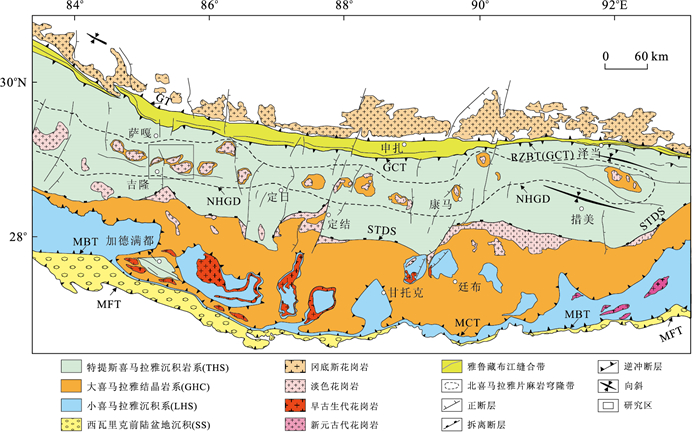
 下载:
下载:
